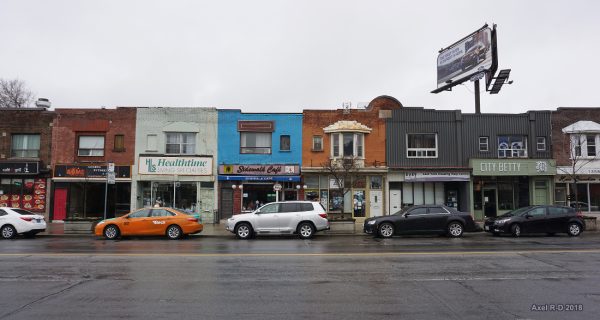In case you hadn’t checked recently, there are, according to the Toronto Parking Authority’s very helpful “Find Parking” map, no fewer than 43 Green P lots along Bloor-Danforth, between Woodbine in the east and the Kingsway in the west. An unscientific visual inspection of said map would indicate that there’s no arterial in Toronto better provisioned with off-street parking than Bloor-Danforth (thanks to the cut-and-cover construction of the subway).
Despite this impressive municipal investment in short-term vehicle storage atop a rapid transit line, non-peak-hours street parking is allowed on much of that very long stretch, for reasons that have not only become increasingly obscure, but now represent an existential threat to the city’s cycling infrastructure and the people who use it.
Indeed, it would be difficult to make a case, in this day and age, for any kind of street parking on a road over a subway. Yet for the most part, the City — with various BIAs yapping in the background — has for years tried the old magic trick of seeking to appease all the various interests that use the spaces between buildings.
I get the idea of deploying parked cars as buffers to protect cyclists. But maybe it’s time to admit that, in the context of the cage match forced upon us by the Ford government, there’s simply not enough right-of-way for the City to try to satisfy all of the road users, all of the time.
The problem with the politics of congestion is that driver attitudes are shaped to a huge degree by personal experiences with gridlock that may or may not have anything to do with what they see as they wait in traffic. The now notorious NHL-players-walking-to-Sunday’s-game from this past weekend is but the most recent example: The culprit was the Santa Claus parade, which was itself re-routed because of the massive construction blockage (the Museum subway entrance project) on Avenue Road south of Bloor. I’m convinced we’re into a world of congestion chain reactions that ripple across the city in unpredictable ways, leaving a slime trail of disgruntlement in their wake.
With bike lanes in particular, I do wonder whether the visual noise along Bloor-Danforth contributes to, or exacerbates, existing driver frustration, which the Ford government has weaponized against cyclists who (needless to add) are travelling along those corridors for precisely the same reason as drivers: heading to work, appointments, school, etc., etc.
So let’s ask the question: what specific constituency does street parking serve on arterials like Bloor-Danforth or the street car routes?
BIAs, mostly. When the St Clair West right-of-way fight was raging, the City sought to mollify the hairs-on-fire merchants and the mewling of former city councillor Cesar Palacio by adding Green P lots/spaces to compensate, apparently on a one-for-one basis, the spots lost to streetcar corridor. The city in that case failed to install bike infrastructure, and instead maintained a great deal of the on-street parking, despite all the public resources that were spent on adding lots all the way along the corridor. St Clair West today is a cyclist’s nightmare.
It’s worth pointing out that the City’s views on on-street parking are by no means consistent, or even coherant. For instance, you can park on much of Bloor/Danforth but not on Yonge south of Bloor. Or think of the vast tracts of the post-war suburbs where street parking on residential streets is forbidden 100% of the time. Meanwhile, some downtown neighbourhoods have exempted themselves from permit parking by pulling the right strings at the right time.
If we’re living in a world where the provincial government is demanding that the City justifies bike lanes on major streets, it seems pretty clear to me that council will finally have to make hard choices about who gets to use the spaces between buildings.
Actually, strike that: not hard choices. Sensible choices: safe and spacious sidewalks, segregated bike lanes, protected transit lanes, sufficient space for vehicles that are in motion.
But in those areas where the city has provided plenty of off-street surface parking, there’s simply no longer any reason to continue a practice that goes back to an era when Toronto had less cars, less density, less traffic and less construction.
Years ago, the legendary planner and urbanist Donald Shoup made the entirely compelling case that free parking comes with an enormous cost to cities. But with Queen’s Park threatening to wield its legislative heft to erase almost two decades of cycling advocacy and infrastructure, I’d argue the high cost of (paid) on-street parking comes at an even greater cost, which is to say the health and well-being of cyclists (and their families), who have every right to get to where they’re going in a safe and efficient manner.
Council, it appears to me, has to make a decision: street parking or cycling infrastructure. The days when the city could try to square this circle are well and truly over.






3 comments
Do the store keepers on any street want their street to be a DESTINATION, where people want to go to, or a WANT-TO-BE EXPRESSWAY, where people want to get past as fast as possible?
The City, at this very moment, is conducting a public survey on parking. This is our opportunity – post passage of Bill 212 – to let them know loud & clear that it’s no longer acceptable to allow on-street parking on commercial streets, especially those with bike lanes.
Yes, Danforth has been a perfect example for a long time of taking advantage of the ample off street options, yet never happened. Not to diminish your very valid points here, but this has entered clown debate territory with Dougi and the drivers. If the city can’t protect the cycling infrastructure, I hope they fire back with something. How about replacing all the removed bike lanes with CafeTO patios?
Diners have rights too!!!
I’m looking forward to the next whack-a-doodle use of the not withstanding clause. LOL